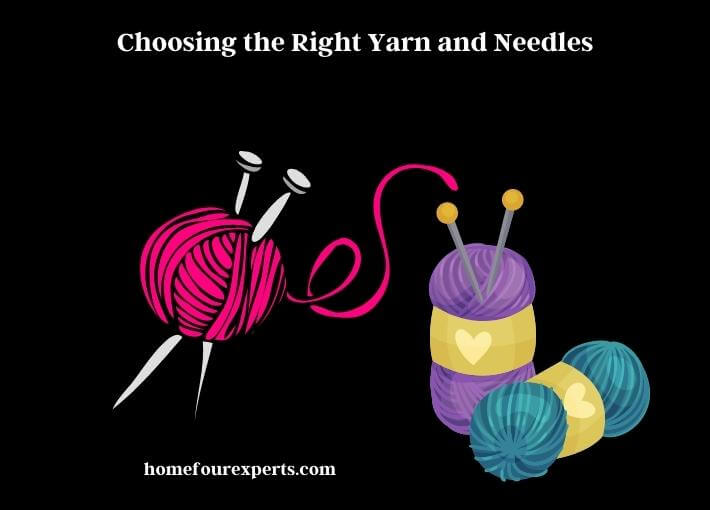Knitting a scarf is a beloved pastime for many people, and for good reason. Not only is it a fun and relaxing activity, but it also allows you to create a stylish and functional winter accessory that can keep you warm and cozy during the cold months. Whether you’re a seasoned knitter or just starting out, knitting a scarf is a great way to practice your skills and express your creativity.

We’ll cover some tips and tricks for knitting a scarf, including choosing the right yarn and needles, learning basic techniques, and trying different patterns. We’ll also provide some pattern ideas for different styles of scarves, so you can find the perfect one to match your taste and personality.
Why Knit a Scarf?
Before diving into the tips, tricks, and patterns for knitting a scarf, it’s worth exploring why you might want to knit a scarf in the first place.
First and foremost, a scarf is a practical accessory for the winter months. It can help keep you warm and protect your neck and chest from the cold, windy weather. By knitting your own scarf, you can customize the length, width, and thickness to your liking, ensuring that it fits you perfectly and provides the right amount of warmth.
In addition to its practical benefits, a scarf can also be a stylish accessory that adds a pop of color or texture to your outfit. By choosing the right yarn and pattern, you can create a scarf that reflects your personal style and enhances your overall look.
Knitting a scarf can be a fun and relaxing activity that allows you to unwind and express your creativity. It can be a great way to reduce stress and anxiety, improve focus and concentration, and provide a sense of accomplishment and satisfaction when you finish your project.
Knitting a scarf is a versatile and rewarding activity that can provide both practical and aesthetic benefits. Whether you’re a seasoned knitter or just starting out, there’s no better time to pick up your needles and start knitting your own stylish winter accessory.
Choosing the Right Yarn and Needles
Choosing the right yarn and needles is essential for knitting a scarf that is both functional and stylish. Here are some tips to help you select the right materials:

Consider the yarn weight: The weight of the yarn you choose will determine the thickness and warmth of your scarf. For a lightweight scarf, choose a fingering or sport-weight yarn. For a thicker, warmer scarf, choose a worsted or bulky-weight yarn.
Check the fiber content: The fiber content of the yarn will affect its softness, durability, and warmth. Wool and wool blends are great for warmth and durability, while silk and cotton blends are soft and lightweight.
Think about the color and texture: The color and texture of the yarn can make a big difference in the final look of your scarf. Consider whether you want a solid color or a variegated one and whether you want a smooth or textured yarn.
Choose the right needles: The size and type of needles you use will also affect the final look and feel of your scarf. For a lightweight scarf, use smaller needles, and for a thicker scarf, use larger needles. Circular needles are great for knitting in the round, while straight needles are better for flat knitting.
Basic Scarf Knitting Techniques
Once you have chosen your yarn and needles, you are ready to start knitting your scarf. Here are some basic techniques you need to know:
Casting on
This is the first step in knitting your scarf. There are many different ways to cast on, but the simplest method is the long-tail cast-on. This method creates a neat and elastic edge that is perfect for scarves.

Knitting and Purling
The two basic stitches in knitting are knitting and purling. Knitting creates a smooth, V-shaped stitch, while purling creates a bumpy, horizontal stitch. By combining these two stitches in different ways, you can create a variety of patterns and textures.
Binding off
This is the last step in knitting your scarf. Binding off creates a neat and finished edge that prevents the stitches from unraveling.
Scarf Patterns
There are many different scarf patterns you can try, depending on your skill level and personal preference. Here are some popular patterns:
Garter Stitch Scarf
This is the simplest scarf pattern, perfect for beginners. It is created by knitting every stitch in every row, which produces a bumpy texture. You can use a single color or multiple colors to create stripes.
Ribbed Scarf
This pattern is created by alternating knit and purl stitches in each row. This creates a stretchy and textured fabric that is perfect for a scarf. You can use a single color or multiple colors to create stripes.
Cable Scarf
This pattern is more advanced and involves knitting cables, which create a twisted and braided effect. It requires a cable needle and some practice, but the result is a beautiful and sophisticated scarf.
Tips and Tricks to Help You Knit a Scarf Like a Pro
Now that you have your yarn and needles, it’s time to get started on knitting your scarf. Here are some tips and tricks to help you knit a scarf like a pro:
Start with a simple pattern: If you’re new to knitting, it’s best to start with a simple pattern that uses basic stitches. Garter stitch, which is just knitting every row, is a great place to start. As you gain more experience, you can move on to more complex patterns.
Use stitch markers: Stitch markers can be helpful for keeping track of where you are in your pattern. Place a stitch marker at the beginning and end of each row to help you stay on track.
Check your tension: Tension refers to how tight or lose you knit. It’s important to maintain consistent tension throughout your project to ensure that it looks even and professional. Take breaks if you need to and check your tension frequently to ensure that it’s consistent.
Use lifelines: Lifelines are a great way to ensure that you don’t lose all your progress if you make a mistake. To create a lifeline, simply thread a piece of scrap yarn through your stitches on a particular row. If you make a mistake later on, you can rip back to the lifeline and start again.
Block your scarf: Once your scarf is complete, block it by wetting it and laying it flat to dry. This will help even out the stitches and give your scarf a polished look.
Patterns for Different Styles
Depending on your personal style and preference, you may want to knit a scarf that reflects your taste. Here are some patterns for different styles:
Classic Scarf
A classic scarf is a timeless accessory that never goes out of style. To knit a classic scarf, you can use a simple pattern, such as the garter stitch or the stockinette stitch. Choose a neutral color, such as black, grey, or beige, for a sophisticated look.
Colorful Scarf
If you want to add some color to your winter wardrobe, a colorful scarf is a perfect choice. You can use multiple colors to create stripes, or you can choose a variegated yarn that changes color as you knit. The ribbed stitch is a great choice for a colorful scarf.
Chunky Scarf
A chunky scarf is not only fashionable but also warm and cozy. You can use bulky yarn and a large needle to create a thick and plush scarf. The seed stitch is a great choice for a chunky scarf.
Advantages and Disadvantages of Knitting a Scarf
Here is a table summarizing the advantages and disadvantages of knitting a scarf:
| Advantages | Disadvantages |
|---|---|
| Personalization: Knitting a scarf allows you to customize it to your style and preferences. | Time-consuming: Knitting a scarf can be a time-intensive process, especially if you are new to knitting or using a complex pattern. |
| Cost-effective: Knitting a scarf can be a more affordable option than buying one from a store. | Requires skill and practice: Knitting requires some level of skill and practice, so it may not be a suitable activity for everyone. |
| Therapeutic benefits: Knitting can be a relaxing and meditative activity that can reduce stress and anxiety. | Potential for mistakes: Mistakes are common in knitting, and they can be frustrating to fix or undo. |
| Creative outlet: Knitting a scarf allows you to express your creativity and experiment with different colors and patterns. | Limited sizing options: If you are knitting a scarf for someone else, it can be challenging to get the sizing right without knowing their measurements. |
Verdict
Knitting a scarf can be a fun and rewarding project, whether you’re a beginner or an experienced knitter. With the right materials and some basic techniques, you can create a stylish and functional winter accessory that you’ll be proud to wear or give as a gift. Remember to choose the right yarn and needles, start with a simple pattern, use stitch markers and lifelines, check your tension, and block your finished scarf for a polished look.
As you gain more experience, don’t be afraid to experiment with more complex patterns and techniques. Knitting a scarf is a great way to hone your skills and express your creativity. So grab your yarn and needles and get started on your next project!
About This Writer

Guys, I am Camila Avery and I love to help my mom to do indoor & outdoor activities. As a lady, I have passed my time on gardening, home improvement, and personal or self-care. I have acquired some degrees in outdoor recreation, beauty, and hair care. It is not easy to work with top-level professional beauty experts. But, I got that opportunity and experimented with different hair extensions, hair colors, and cuts.